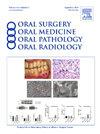低分化梭形细胞癌伴横纹肌母细胞分化:免疫组织化学解释的重点
IF 1.9
3区 医学
Q2 DENTISTRY, ORAL SURGERY & MEDICINE
Oral Surgery Oral Medicine Oral Pathology Oral Radiology
Pub Date : 2025-07-21
DOI:10.1016/j.oooo.2025.04.070
引用次数: 0
摘要
表现为横纹肌母细胞分化的头颈部肿瘤包括横纹肌肉瘤、平滑肌肉瘤、滑膜肉瘤、梭形细胞癌(SpCC)、恶性周围神经鞘肿瘤或转移性疾病。梭形细胞癌(SpCC)是一种罕见的鳞状细胞癌(SCC)亚型,常见于口腔和喉部。溃疡表面上皮完全缺乏表面发育不良上皮,呈现完全梭形细胞增殖的病例可构成诊断挑战。此外,免疫组织化学(IHC)可以证明分化为可变间质成分的证据。我们报告了一例低分化SpCC伴横纹肌细胞分化,横纹肌细胞生物标志物MyoD-1呈阳性。病例介绍:一名54岁女性因下颌前龈有一结节状肿块,形似化脓性肉芽肿而就诊。在组织病理学检查中,H&;E组织切片显示任何表面上皮的溃疡团块,恶性梭形细胞侵入结缔组织。梭形细胞表现出多种恶性特征,包括多形性、深染、核质比增加和非典型有丝分裂象。它们排列成短而交错的束状。大量嗜酸性细胞质伴横纹肌细胞分化。初始免疫组化分析显示Myo-D1弥漫性阳性,Desmin局灶性阳性,Myogenin、SMA、h-Caldesmon阴性。然而,全细胞角蛋白弥漫性阳性证实了SpCC的诊断。其他细胞角蛋白、p53、p63、p40、TLE-1、CD99、神经标志物均为阴性。马里兰大学医学中心的外科治疗包括复合下颌骨切除术和双侧颈部清扫,随后进行辅助放疗和化疗。手术病理结果为神经周围浸润阳性,所有淋巴结和组织边缘阴性。结论本病例强调了SpCC缺乏表面上皮的诊断挑战。病理学家也应该意识到SpCC中横纹肌母细胞分化的可能性,并谨慎地解释骨骼肌生物标志物,因为其表达模式多变。本文章由计算机程序翻译,如有差异,请以英文原文为准。
Poorly differentiated spindle cell carcinoma with rhabdomyoblastic differentiation: highlights on immunohistochemistry interpretation
Introduction
Tumors of the head and neck that exhibit rhabdomyoblastic differentiation include rhabdomyosarcoma, leiomyosarcoma, synovial sarcoma, spindle cell carcinoma (SpCC), malignant peripheral nerve sheath tumor, or metastatic disease. Spindle cell carcinoma (SpCC) is a rare subtype of squamous cell carcinoma (SCC) typically seen in the oral cavity and larynx. Cases with ulcerated surface epithelium completely devoid of surface dysplastic epithelium that present entirely of a spindle cell proliferation can pose a diagnostic challenge. Additionally, immunohistochemistry (IHC) can demonstrate evidence of differentiation to variable mesenchymal components. Here we present a poorly differentiated SpCC with rhabdomyoblastic differentiation as evidenced by positivity for the rhabdomyoblastic biomarker MyoD-1.
Case Presentation
A 54-year-old female presented to her dentist with a nodular mass on the anterior mandibular gingiva mimicking a pyogenic granuloma. Upon histopathological examination, H&E tissue sections showed an ulcerated mass devoted of any surface epithelium with malignant spindle cells invading the connective tissue. The spindle cells showed several malignant criteria including pleomorphism, hyperchromatism, increased nuclear-to-cytoplasmic ratio, and atypical mitotic figures. They were arranged in short interlacing fascicles. Abundant eosinophilic cytoplasm with rhabdomyoblastic differentiation was featured. Initial IHC analysis showed diffuse positivity for Myo-D1, focal positivity for Desmin, and negativity for Myogenin, SMA, h-Caldesmon. However, Pancytokeratin, was diffusely positive confirming the diagnosis of SpCC. Other cytokeratins, p53, p63, p40, TLE-1, CD99, and neural markers were all negative. Surgical management at the University of Maryland Medical Center included composite mandibulectomy and bilateral neck dissection, followed by adjuvant radiotherapy and chemotherapy. Surgical pathology findings were positive for perineural invasion, negative for all lymph nodes and tissue margins.
Conclusion
This case highlights the challenge in diagnosing cases of SpCC devoid of surface epithelium. Pathologists should also be aware of the possibility of rhabdomyoblastic differentiation in SpCC and cautiously interpret skeletal muscle biomarkers given the variable expression patterns.
求助全文
通过发布文献求助,成功后即可免费获取论文全文。
去求助
来源期刊

Oral Surgery Oral Medicine Oral Pathology Oral Radiology
DENTISTRY, ORAL SURGERY & MEDICINE-
CiteScore
3.80
自引率
6.90%
发文量
1217
审稿时长
2-4 weeks
期刊介绍:
Oral Surgery, Oral Medicine, Oral Pathology and Oral Radiology is required reading for anyone in the fields of oral surgery, oral medicine, oral pathology, oral radiology or advanced general practice dentistry. It is the only major dental journal that provides a practical and complete overview of the medical and surgical techniques of dental practice in four areas. Topics covered include such current issues as dental implants, treatment of HIV-infected patients, and evaluation and treatment of TMJ disorders. The official publication for nine societies, the Journal is recommended for initial purchase in the Brandon Hill study, Selected List of Books and Journals for the Small Medical Library.
 求助内容:
求助内容: 应助结果提醒方式:
应助结果提醒方式:


